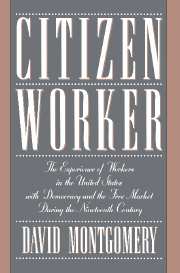 Citizen Worker
Citizen Worker 1 - Wage Labor, Bondage, and Citizenship
Published online by Cambridge University Press: 16 November 2009
Summary
During the eighteenth century merchant capital had encouraged the production of commodities through a variety of labor systems, ranging from the total subjugation of the slave to such autonomy among artisans and yeomen as was seldom to be found in either previous or subsequent human experience. It also underwrote established privilege and power based on family lineage and personal access to the levers of government. The rural and urban popular mobilizations of the late eighteenth and early nineteenth centuries, which democratized the American political system, also undermined the personal forms of subordination that had bound many working people for shorter or longer periods to masters, but that had also obligated both masters and municipal authorities to care for basic needs of working people and those who could not work.
In the late eighteenth century hired labor had coexisted with and often been overshadowed by slavery, indentured servitude, apprenticeship, and other forms of bound labor. Moreover, the largest concentrations of wage earners had been found among merchant seamen, who were subject to physical punishments and for whom quitting during the period for which they had signed on was the criminal offense of desertion. By the 1820s, however, the swelling ranks of men and women dependent on wages for their livelihood and on rental for their dwellings had made wage contracts so commonplace that they provided a norm in terms of which other social and political relationships were defined.
- Type
- Chapter
- Information
- Citizen WorkerThe Experience of Workers in the United States with Democracy and the Free Market during the Nineteenth Century, pp. 13 - 51Publisher: Cambridge University PressPrint publication year: 1994


